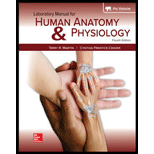
Concept explainers
The outermost layer of connective tissue of a muscle is the
a. fascicle.
b. endomysium.
c. epimysium
d. perimysium.
Introduction:
The types of tissue found in the animal are the epithelial tissue, muscle tissue, connective tissue, and the nervous tissue. The connective tissue is developed from the mesoderm layer of the embryo. This tissue is found in almost all tissues and organs of the body.
Answer to Problem 1PL
Correct answer:
Option (c), epimysium.
Explanation of Solution
Explanation/justification for the correct answer:
Option (c) is epimysium. It is the outermost layer of the connective tissue that encircles the fascicles. Hence, this option is correct.
Explanation for incorrect answer:
Option (a) is fascicle. It is a bundle of nerves or muscle fibers that are surrounded by connective tissue. Hence, this option is incorrect.
Option (b) is endomysium. This is the innermost layer of the connective tissue that surrounds each muscle fiber. Hence, this option is incorrect.
Option (d) is perimysium. It is the middle layer of the connective tissue that surrounds the muscle fibers forming a fascia.
Option (c), epimysium.
Want to see more full solutions like this?
Chapter 20 Solutions
Laboratory Manual For Human Anatomy & Physiology
- What are the structural and functional differences between slow and fast muscle?arrow_forwardFollowing an injury to a nerve, the muscle it supplies with motor nerve fibers may become paralyzed. How would you explain to a patient the importance of moving the disabled muscles passively or contracting them using electrical stimulation?arrow_forwardIf a muscle is contracted and shortening, what happens to the following: (a) width of the A band, (b) width of the H zone, (c) relationship of the Z discs, and (d) width of the I band?arrow_forward
- After a vigorous exercise, you may experience cramps in your leg muscles. Why does this happen?arrow_forwardWhat are the muscle fiber orientations and why would the body choose one orientation over another?arrow_forwardunder a microscope, some skeletal muscles appear white and some look red. What type of muscle appears white? What type of muscle appears red? What accounts for this difference?arrow_forward
- What is the name of the connective tissue that binds several muscle fibres into a bundle or fascicle?arrow_forwardWhen this large muscle contracts, the vertical dimensions of the thoracic cavity increase. a. external intercostal b. internal intercostal c. diaphragm d. transversus thoracisarrow_forwardWhich types of muscle have t-tubules, sarcoplasmic reticulum?arrow_forward
- If a muscle cell had very short T-tubules, how much tension would the muscle fiber create, relative to a normal muscle fiber? Assume sarcoplasmic reticulum can still react to activity at the neuromuscular junction. a)Less tension would be created. b) No difference in tension creation. c) More tension would be created. d) No tension would be created.arrow_forwardWhat is the correct order of the structures of a muscle?arrow_forwardFast-twitch muscle fibers are also called type ________fibers and slow-twitch are called type _____________fibers. A, B I, II II, I B, Aarrow_forward
 Comprehensive Medical Assisting: Administrative a...NursingISBN:9781305964792Author:Wilburta Q. Lindh, Carol D. Tamparo, Barbara M. Dahl, Julie Morris, Cindy CorreaPublisher:Cengage Learning
Comprehensive Medical Assisting: Administrative a...NursingISBN:9781305964792Author:Wilburta Q. Lindh, Carol D. Tamparo, Barbara M. Dahl, Julie Morris, Cindy CorreaPublisher:Cengage Learning Medical Terminology for Health Professions, Spira...Health & NutritionISBN:9781305634350Author:Ann Ehrlich, Carol L. Schroeder, Laura Ehrlich, Katrina A. SchroederPublisher:Cengage Learning
Medical Terminology for Health Professions, Spira...Health & NutritionISBN:9781305634350Author:Ann Ehrlich, Carol L. Schroeder, Laura Ehrlich, Katrina A. SchroederPublisher:Cengage Learning Human Biology (MindTap Course List)BiologyISBN:9781305112100Author:Cecie Starr, Beverly McMillanPublisher:Cengage Learning
Human Biology (MindTap Course List)BiologyISBN:9781305112100Author:Cecie Starr, Beverly McMillanPublisher:Cengage Learning




